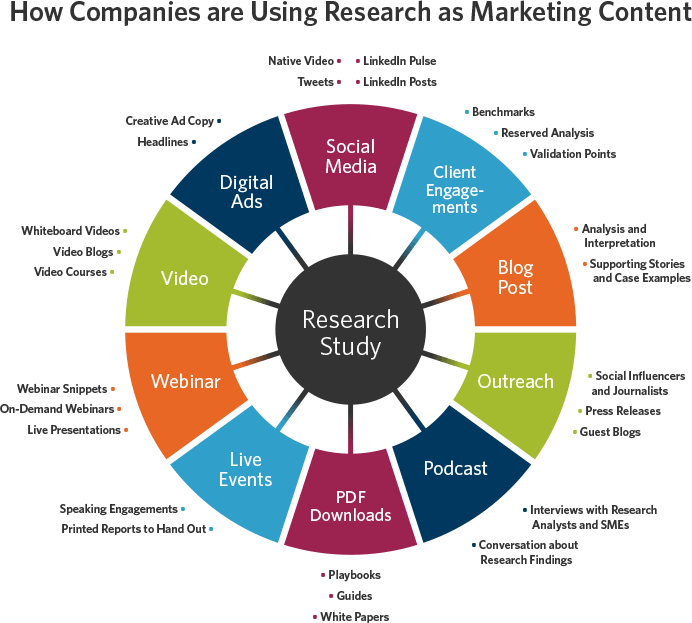“How can I use research as marketing content?”
A challenging question, to be sure. It’s one that I find stumps many of my clients, making it one of my favorite questions to answer. Once I present the different points I share in this article, I can see the wheels start turning and I know I’ve gotten their attention.
One of the many factors that contributes to the impressive growth of the firms that we study in our annual High Growth Study comes from conducting and publishing primary research. High Growth firms are using data to reduce the uncertainty we are all facing by sharing this information to reach new audiences, generate leads, and as validation for their services.

It’s one thing to have the data, but making sure that it’s distributed effectively is equally as important.
Researching an issue or topic important to your target buyers gives you “seed” content to distribute on a variety of channels and platforms (see the image below). When used strategically, one research report can fuel an entire year’s worth of marketing campaigns.

Come on down and spin the wheel! Here are 27 different content distribution ideas to promote your primary research.
Social Media
- Native Video — social media algorithms (especially LinkedIn’s) love native video. By uploading video focused on one or two key research findings, it creates content unique to that social platform.
- Tweets — I love Twitter because it forces marketers to refine messages and get their point across in 280 characters. Research gives marketers valuable content to share and distribute. 20 statistics can easily turn into 20 scheduled Tweets.
- LinkedIn Polls — The polling feature on LinkedIn allows you to dig a little bit deeper into your unique audience as an individual and collect more data around any key points. It’s also a great way to start conversations with members of your network once you see how they respond to the polls.
- LinkedIn Posts — Like tweets, LinkedIn posts are unique to LinkedIn. But unlike Twitter, you have 3,000 characters to work with, giving you much more breathing room to write about each research statistic you choose to profile.
Digital Advertisements
- Creative Ad Copy — When running visual advertisements like banner ads or ads on social, you could incorporate a research statistic into the creative. Just because it’s a statistic doesn’t mean it has to be dull…
- Headlines — As people, we like things to be easy to understand. By using statistics in headlines, you are able to get your main point across in a clear and concise way. Using research statistics and make your headlines stand out.
Video
- Video blogs — With much of the world working from home, the days of stuffy, heavily scripted talking heads in front of a green screen are behind us. Taking 1-2 minutes to record a video highlighting some key data points from the comfort of your home office is a low effort, high return activity for engagement.
- Short-form video — Grab that smartphone tripod you use for all of your other TikTok videos and record your research-based ramblings right to your cell phone. This raw style of video is popping up on every social platform and is just as successful for B2B firms.
- Video courses — E-learning is a popular way for business owners to learn new skills and for enterprise organizations to train their staff on specific topic areas. By incorporating research into your video courses, it adds credibility to your lesson.
Webinars
- Live webinar presentations — Webinars and primary research go together like peanut butter and jelly. If you conducted the research, host a webinar to distribute the results with your audience. If you license research, you could co-present with an analyst from the publishing organization.
- On-demand webinars — The value of a webinar isn’t over once you end the live presentation. Take the live webinar you presented in and offer it on-demand to your audience. This is a great way to build up an arsenal of valuable content that you can use to nurture leads and allow web visitors to find organically.
- Webinar snippets — Take the on-demand webinar video file you have and isolate 1-3 minute clips to be promoted on social media, web pages, email and more. This is great fodder for social media, targeted email campaigns and specific web pages..
Live Events
- Speaking engagements — Need a unique presentation topic to get booked for the conference that all of your target prospects are attending? Look no further than the findings from your primary research!
- Printed reports to hand out — You download a digital research report, and then chances are it gets lost on your desktop or your downloads folder. Instead, have your report really stand out. Print copies of your research report, spiral bind it together, and hand them out to target accounts at live events. (BONUS — mail them to prospects with a handwritten note)
PDF Downloads
- Playbooks — 2-minutes to go in the fourth quarter… What plays are you going to use to drive the ball downfield and win the game? Let’s hope those plays are founded in primary research… Playbooks are an effective tool, especially in Account Based Marketing (ABM) strategies. These are great ways to distribute research-based content internally.
- How-to Guides — If your clients wanted to DIY the services they’re using you for, how would they do it? Here you can use primary research to illustrate why your process is effective, or leverage aggregate client results to demonstrate success.
- Technical White Papers — By using primary research to help describe how a technology, product or service addresses a particular buyer challenge, you can reinforce your credibility and expertise on the subject.
Podcasts
- Interviews with research analysts — If you co branded a research study with another organization, you could interview one of their analysts on your podcast. This is a great way to add validity to the research, and best of all? You don’t run the risk of being seen as self-promotional.
- Conversations about research findings — Our latest research suggests less than 12% of B2B and professional services firms have a podcast. If you don’t have one, that’s OK. Pitch your research as a topic to other podcasts and go on their shows as guests. Tailor your conversation and how you frame the research to resonate with that particular audience.
Outreach
- Press releases — This is a tried and true way of promoting a research study. Sending out a press release about your research gives journalists an opportunity to pick up stats and use them in their articles, giving your research the chance of reaching far and wide.
- Guest blogs — Pitch a topic supported by your research to external publications that overlap with your target audience. This is another great way of increasing the visibility of your primary research and expertise.
- Influencers & journalists — Influencer marketing has taken over B2C, and there have been noted success stories in B2B. If you can get a notable Visible Expert within a given industry to start talking about your research, it adds credibility and boosts visibility.
Blog Posts
- Analysis and interpretation — You may need to write up the formal research report one way, but blogging is a great way to add analysis in your own voice about the primary research study. This adds character and depth to the narrative around the research.
- Supporting stories and case examples — Everyone loves a good story. That’s probably why storytelling is such a hot topic in marketing. But when you take a good story and add compelling empirical evidence? That’s twice as compelling.
Client Engagements
- Benchmarks — So… how do I stack up against my competitors? Some research can act as benchmarks to which you can compare your clients. This is one way you can distribute research-based content to add value to your client engagements.
- Reserved analysis — You don’t have to publish all of the results. Another way to add value to client engagements is to reserve some of your analysis to share exclusively with your clients.
- Validation points — If you are recommending a specific course of action to your clients, research can be a good way to validate your approach. This is what you should do, and here’s research to back it up.
Summary
So, there you have it. 27 different examples for ways to share your primary research data with the rest of the world. That means that there are at least 27 different ways to extend the shelf life of your research study. Reading this article also gives you a little bit of a peek behind the Hinge content development curtain as we consider all of these methods as ways to promote our research.
Repurposing content is an efficient use of time for every marketer. If you’re interested in learning more about how to make this dream a part of your reality, send us a message. We’d love to help.



